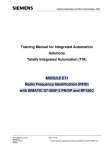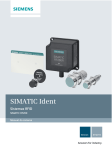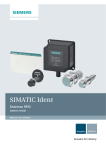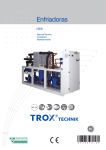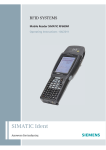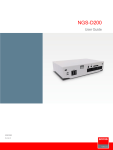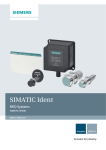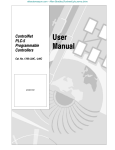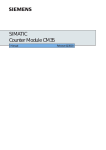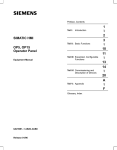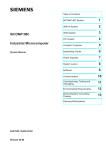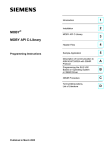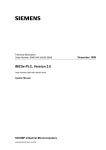Download Display - Service, Support
Transcript
RFID Systems SIMATIC RF310M Mobile Reader Operating Instructions · 07/2007 SIMATIC RF310M Mobile Reader simatic sensors DOCUMENTATION SIMATIC Sensors RFID Systems SIMATIC RF310M Mobile Reader Operating Instructions Introduction 1 Description 2 Power supply 3 Commissioning 4 Operation 5 SIMATIC RF310M software 6 Advanced functions 7 Error messages of the SIMATIC RF310M application Troubleshooting Technical Specifications Appendix 07/2007 J31069-D0191-U001-A1-7618 8 9 10 A Safety Guidelines This manual contains notices you have to observe in order to ensure your personal safety, as well as to prevent damage to property. The notices referring to your personal safety are highlighted in the manual by a safety alert symbol, notices referring only to property damage have no safety alert symbol. These notices shown below are graded according to the degree of danger. DANGER indicates that death or severe personal injury will result if proper precautions are not taken. WARNING indicates that death or severe personal injury may result if proper precautions are not taken. CAUTION with a safety alert symbol, indicates that minor personal injury can result if proper precautions are not taken. CAUTION without a safety alert symbol, indicates that property damage can result if proper precautions are not taken. NOTICE indicates that an unintended result or situation can occur if the corresponding information is not taken into account. If more than one degree of danger is present, the warning notice representing the highest degree of danger will be used. A notice warning of injury to persons with a safety alert symbol may also include a warning relating to property damage. Qualified Personnel The device/system may only be set up and used in conjunction with this documentation. Commissioning and operation of a device/system may only be performed by qualified personnel. Within the context of the safety notes in this documentation qualified persons are defined as persons who are authorized to commission, ground and label devices, systems and circuits in accordance with established safety practices and standards. Prescribed Usage Note the following: WARNING This device may only be used for the applications described in the catalog or the technical description and only in connection with devices or components from other manufacturers which have been approved or recommended by Siemens. Correct, reliable operation of the product requires proper transport, storage, positioning and assembly as well as careful operation and maintenance. Trademarks All names identified by ® are registered trademarks of the Siemens AG. The remaining trademarks in this publication may be trademarks whose use by third parties for their own purposes could violate the rights of the owner. Disclaimer of Liability We have reviewed the contents of this publication to ensure consistency with the hardware and software described. Since variance cannot be precluded entirely, we cannot guarantee full consistency. However, the information in this publication is reviewed regularly and any necessary corrections are included in subsequent editions. Siemens AG Automation and Drives Postfach 48 48 90437 NÜRNBERG GERMANY Ordernumber: J31069-D0191-U001-A1-7618 Ⓟ 07/2007 Copyright © Siemens AG 2007. Technical data subject to change Table of contents 1 Introduction................................................................................................................................................ 7 2 Description................................................................................................................................................. 9 3 4 5 6 2.1 Application area .............................................................................................................................9 2.2 Features .......................................................................................................................................10 2.3 Design ..........................................................................................................................................11 2.4 Antenna and antenna field ...........................................................................................................12 Power supply ........................................................................................................................................... 13 3.1 Inserting the battery .....................................................................................................................13 3.2 Charging function.........................................................................................................................14 3.3 Using other batteries....................................................................................................................15 3.4 The backup battery ......................................................................................................................15 Commissioning ........................................................................................................................................ 17 4.1 Scope of supply ...........................................................................................................................17 4.2 Switching on the device ...............................................................................................................18 4.3 4.3.1 4.3.2 4.3.3 Basic settings ...............................................................................................................................19 Setting the language ....................................................................................................................19 Adjusting the acoustic signal volume...........................................................................................20 Adjusting the screen backlighting and contrast ...........................................................................20 Operation................................................................................................................................................. 21 5.1 5.1.1 5.1.2 The keypad ..................................................................................................................................21 The shift keys ...............................................................................................................................21 Key functions................................................................................................................................22 5.2 The SIMATIC RF310M menu ......................................................................................................24 SIMATIC RF310M software ..................................................................................................................... 25 6.1 Overview of functions...................................................................................................................25 6.2 Starting the SIMATIC RF310M software .....................................................................................26 6.3 The data editor .............................................................................................................................26 6.4 6.4.1 6.4.2 6.4.3 The functions in the "File" menu ..................................................................................................28 Loading a file................................................................................................................................28 Save .............................................................................................................................................28 Exit ...............................................................................................................................................29 6.5 6.5.1 6.5.2 6.5.3 The functions in the "Tag" menu..................................................................................................30 Progress and timeout display.......................................................................................................31 Requirements for operating the tag functions..............................................................................32 Read tag (MDS) ...........................................................................................................................34 SIMATIC RF310M Mobile Reader Operating Instructions, 07/2007, J31069-D0191-U001-A1-7618 5 Table of contents 7 6.5.4 6.5.5 6.5.6 6.5.7 6.5.8 6.5.9 6.5.10 Read OTP ................................................................................................................................... 35 Reading the tag configuration data ............................................................................................. 36 Writing to the tag ......................................................................................................................... 37 Write OTP.................................................................................................................................... 38 Read tag status ........................................................................................................................... 39 Reading the tag ID ...................................................................................................................... 39 Initialize the tag ........................................................................................................................... 39 6.6 6.6.1 6.6.2 6.6.3 6.6.4 The functions in the "Editor" menu.............................................................................................. 40 Jump to Address ......................................................................................................................... 40 Display......................................................................................................................................... 41 Clear............................................................................................................................................ 41 Data Edit...................................................................................................................................... 42 6.7 6.7.1 6.7.2 6.7.3 6.7.4 6.7.5 The functions in the "Extras" menu............................................................................................. 43 Password..................................................................................................................................... 44 Language .................................................................................................................................... 44 Address Setup............................................................................................................................. 45 Tag Type Selection ..................................................................................................................... 46 SLG Status .................................................................................................................................. 47 6.8 The functions in the "?" menu ..................................................................................................... 48 Advanced functions ................................................................................................................................. 49 7.1 File storage on the RF310M........................................................................................................ 49 7.2 7.2.1 7.2.2 7.2.3 Copying data from and to the Mobile Reader ............................................................................. 50 Prerequisites ............................................................................................................................... 50 Working with the Active Sync program ....................................................................................... 51 Organization of the file READ.HEX............................................................................................. 53 7.3 The automatic power-saving function ......................................................................................... 54 7.4 System reset ............................................................................................................................... 54 8 Error messages of the SIMATIC RF310M application.............................................................................. 55 9 Troubleshooting ....................................................................................................................................... 61 10 Technical Specifications .......................................................................................................................... 63 A Appendix.................................................................................................................................................. 65 A.1 FCC information .......................................................................................................................... 65 A.2 Accessories ................................................................................................................................. 65 A.3 Ordering components for advanced functions ............................................................................ 66 A.4 Developing user applications ...................................................................................................... 66 A.5 ASCII table .................................................................................................................................. 67 A.6 Service and support .................................................................................................................... 68 A.7 Contacts ...................................................................................................................................... 68 A.8 Training ....................................................................................................................................... 69 Glossary .................................................................................................................................................. 71 Index........................................................................................................................................................ 73 6 SIMATIC RF310M Mobile Reader Operating Instructions, 07/2007, J31069-D0191-U001-A1-7618 1 Introduction Purpose of this document These operating instructions contain information required for starting up and using the RF310M device. The documentation is aimed at commissioning engineers and machine operators who start up the application themselves, and it describes the functions of the "SIMATIC RF310M" software. Scope of validity of this document This documentation is valid for the SIMATIC RF310M Mobile Reader and describes the delivery status from July 2007. Further information The present instructions are a supplement to the operating instructions of the basic device PSION WORKABOUT PRO. The documents "Quick Reference Guide" and "Regulatory & Warranty Guide" for "WORKABOUT PRO C/M-E Hand-Held Computer" are included with the device. Please note the information they contain. You can find further information in the PSION User Manual and in the documentation for the docking station. Conventions The following terms/abbreviations are used synonymously in this document: ● tag, transponder, mobile data memory (MDS), data carrier ● Reader, read/write device (SLG) History Previous editions of these operating instructions: Edition Remarks 07/2007 First edition SIMATIC RF310M Mobile Reader Operating Instructions, 07/2007, J31069-D0191-U001-A1-7618 7 Introduction 8 SIMATIC RF310M Mobile Reader Operating Instructions, 07/2007, J31069-D0191-U001-A1-7618 Description 2 SIMATIC RF310M expands the RF300 RF identification system with a powerful mobile handheld reader for applications in the areas of production and service. In addition, it is an indispensable aid for startup and testing. 2.1 Application area The RF300 Mobile Reader is intended especially for the SIMATIC RF300 RFID system. The enclosed SIMATIC RF310M software allows user-friendly, distributed reading and writing of all RF300 tags. The Mobile Reader can also be used in harsh environments. The Mobile Reader is extremely rugged and protected against spray water. The backlit display is easy to read even under unfavorable lighting conditions. SIMATIC RF310M Mobile Reader Operating Instructions, 07/2007, J31069-D0191-U001-A1-7618 9 Description 2.2 Features 2.2 Features The SIMATIC RF310M Mobile Reader consists of a powerful, rugged and flexible handheld computer (PSION WORKABOUT PRO) and an integral read/write unit for the SIMATIC RF300 RFID system. It meets the requirements of mobile RFID data acquisition in harsh environments in an extremely user-friendly and ergonomic design. Based on communications standards, the device guarantees simple integration into existing or planned infrastructure. The following functions can be executed: Functions ● Reading the data from the tag (data memory) ● Writing the data to the tag ● Deleting the entire data memory (overwriting it with a filler) ● Reading and displaying the ID number of the tag ● Reading the data carrier status (MDS status) ● Reading the status of the read/write unit (SLG) ● Representing and editing the data in hexadecimal and ASCII format ● Activatable/deactivatable password protection for all write functions and for terminating the program ● Menu prompting in English and German (switchable) ● Saving of the read-in RF300 data to files. The Mobile Reader has approximately 1.8 MB available for this purpose. The RFID read/write unit of RF300 is integrated into the PSION basic unit. Communication with the basic unit is handled via the internal serial scanner port that also supplies the power for the RFID unit. Accessories The charging and docking station (including wide-range power supply unit, 100 to 240 V AC, 50 to 60 Hz) for recharging the battery and connecting to PCs via USB port must be ordered separately. This station has a charging bay for an additional replacement battery. See Accessories (Page 65). 10 SIMATIC RF310M Mobile Reader Operating Instructions, 07/2007, J31069-D0191-U001-A1-7618 Description 2.3 Design 2.3 Design The RF300 Mobile Reader consists of a basic unit and an integral read/write head (①) of the SIMATIC RF300. The basic unit is a PSION Workabout PRO and represents a global standard among mobile readers. The SIMATIC RF310M software is stored in an integral flash disk secure against power failure. The program launches automatically when the Mobile Reader is switched on. The separately available accessories include a charging and docking station (④) with USB port for data exchange with the PC. All RF300 data memories can be edited with the Mobile Reader. It is not possible to edit data memories of other RFID systems. Design of the SIMATIC RF310M Item Description ① Read/write head ② Holder for input pen ③ On/off button ④ Charging cradle ⑤ Power supply ⑥ ASCII keypad ⑦ Numeric keys ⑧ Charge indicator (LED) ⑨ Display ⑩ Function indicator (LED) for read/write operations LED lights up: • Green: an action is being successfully carried out. This increases the power consumption of the RF310M via the read/write head. • Red: Internal error processing of the application; no action is required from the user. SIMATIC RF310M Mobile Reader Operating Instructions, 07/2007, J31069-D0191-U001-A1-7618 11 Description 2.4 Antenna and antenna field 2.4 Antenna and antenna field Read head with integral antenna The antenna is housed in the read head ① under a cover. Figure 2-1 Read head with antenna Direction of propagation of the high-frequency field The read/write area for transponders is above and below the front part of the housing. Transponders cannot be read or written to from the end. The figure below shows the direction of propagation of the HF field of the antenna. Figure 2-2 12 Propagation of the HF field SIMATIC RF310M Mobile Reader Operating Instructions, 07/2007, J31069-D0191-U001-A1-7618 3 Power supply 3.1 Inserting the battery The Mobile Reader's battery is located on the rear of the unit. Steps for inserting the battery 1. Use the other end of the input pen as a screwdriver: 2. Turn the screws counter-clockwise. 3. To remove the cover, lift the screw side first. 4. Hold the battery at an angle when inserting so that the side of the battery with the direction arrow is inserted into the battery compartment first. SIMATIC RF310M Mobile Reader Operating Instructions, 07/2007, J31069-D0191-U001-A1-7618 13 Power supply 3.2 Charging function 3.2 Charging function Complete charging of an empty battery takes approximately 5 hours. Starting the charging operation The charging operation is started as soon as you insert the PSION Workabout Pro into the charging cradle. WARNING Explosion hazard when using a different charging cradle. Use only the original charging cradle from PSION. Use of another charging station can result in explosions and serious personal injury. Detecting the level of charge You can check the level of charge via the charge indicator (LED) on the Mobile Reader: Table 3-1 LED color LED status Green Flashing Charging in progress. Permanently lit Battery is fully charged. Flashing Charging not in progress. Battery fault! Permanently lit External temperature too high. Red 14 Status LED Meaning SIMATIC RF310M Mobile Reader Operating Instructions, 07/2007, J31069-D0191-U001-A1-7618 Power supply 3.3 Using other batteries 3.3 Using other batteries Other AA batteries can be used in the PSION Workabout Pro . These can be rechargeable lithium ion batteries or non-rechargeable alkaline batteries. CAUTION Information in the PSION manual concerning the use of other batteries When using other batteries, please note the information in the PSION User Manual! Unsuitable batteries can result in damage. 3.4 The backup battery The backup battery in the unit PSION Workabout Pro is used for retaining the application data when the main batteries are uncharged. The backup battery is a lithium cell that cannot be charged. Please note that a new backup battery (in the case of an empty or removed main battery) can only retain the data in the RAM for a few minutes. SIMATIC RF310M Mobile Reader Operating Instructions, 07/2007, J31069-D0191-U001-A1-7618 15 Power supply 3.4 The backup battery 16 SIMATIC RF310M Mobile Reader Operating Instructions, 07/2007, J31069-D0191-U001-A1-7618 4 Commissioning 4.1 Scope of supply The scope of supply of the RF310M comprises several components. Ordered components Order No. Mobile Reader SIMATIC RF310M 6GT2803-0AA00 with integral RFID read/write unit for RF300 SIMATIC RF310M Mobile Reader Operating Instructions, 07/2007, J31069-D0191-U001-A1-7618 17 Commissioning 4.2 Switching on the device 4.2 Switching on the device Requirements for startup ● The Mobile Reader SIMATIC RF310M is ready-mounted ● The unit's battery is charged (see Charging function (Page 14)). Note Before switching the device on for the first time, you must insert the Mobile Reader into the charging cradle and charge it for approximately 5 hours. Switching on the device To switch the Mobile Reader on, press and hold the red "ENTER ON" button for at least one second. Figure 4-1 <ENTER ON>/<OFF> key After switching on, the first power-up lasts a few seconds. The RF310M application launches automatically. Switching the device off To switch the SIMATIC RF310M Mobile Reader off, press the blue key and then the <ENTER ON> key. Automatic shutdown of the device The device shuts down automatically if no key is pressed for 5 minutes. After switching on again, the Mobile Reader continues to operate with the same interface it was using before it was manually or automatically switched off. See also The automatic power-saving function (Page 54) 18 SIMATIC RF310M Mobile Reader Operating Instructions, 07/2007, J31069-D0191-U001-A1-7618 Commissioning 4.3 Basic settings 4.3 Basic settings 4.3.1 Setting the language You can set the following menu languages for operating the Mobile Reader SIMATIC RF310M: ● English ● German Procedure for selecting the language Select the desired language in the "Language selection" window of the "Extras > Language" menu and confirm with "OK". Figure 4-2 Language selection window SIMATIC RF310M Mobile Reader Operating Instructions, 07/2007, J31069-D0191-U001-A1-7618 19 Commissioning 4.3 Basic settings 4.3.2 Adjusting the acoustic signal volume The tag functions trigger an acoustic signal indicating whether the operations were successful or were terminated with an error. You can switch these acoustic acknowledgements/signals on and off and you can regulate their volume. Adjusting the volume of the acoustic signals 1. Press the blue key twice in succession so that "BLUE KEY" appears on the right of the display. 2. Regulate the volume of the acoustic signals using the keys "A" (quieter) and "B" (louder). Figure 4-3 Keys for regulating the volume Specific setting of the acoustic signals Select "My Computer > Control Panel > Volume & Sounds" on the desktop. On the "Volume" tab, you can regulate the volume between "Soft" and "Loud" using the bar. You can also permit or deactivate acoustic signals for different messages by activating the relevant checkboxes. 4.3.3 Adjusting the screen backlighting and contrast You can adjust the brightness of the screen by pressing the following key: Key Function Changing the backlighting 20 SIMATIC RF310M Mobile Reader Operating Instructions, 07/2007, J31069-D0191-U001-A1-7618 5 Operation 5.1 The keypad 5.1.1 The shift keys Pressing a shift key causes a change in the function of the subsequently pressed keys. The following keys of the SIMATIC RF310M are shift keys: ● <SHIFT> ● <CTRL> ● <ALT> ● <ORANGE> (changes the key assignment in accordance with the orange-colored labeling on the keypad) ● <BLUE> (changes the key assignment in accordance with the blue-colored labeling on the keypad) Activating the shift keys: When you press a shift key, the name of the selected switch key appears in lowercase in the task bar, e.g. "org key", "blue key". Any subsequently pressed key then changes its function, the display in the task bar disappears and the shift key is deactivated again. Defining shift keys If the shift key is to remain set, it must be pressed twice in succession. The display in the task bar then appears in uppercase, e.g. "ORG KEY, "BLUE KEY". If the shift key is pressed a third time, it is deactivated again and the display in the task bar disappears. SIMATIC RF310M Mobile Reader Operating Instructions, 07/2007, J31069-D0191-U001-A1-7618 21 Operation 5.1 The keypad 5.1.2 Key functions Overview of the keypad Figure 5-1 22 Overview of the keypad SIMATIC RF310M Mobile Reader Operating Instructions, 07/2007, J31069-D0191-U001-A1-7618 Operation 5.1 The keypad Key functions Table 5-1 Item ① ② ③ ④ ⑤ ⑥ ⑦ ⑧ ⑨ ⑩ Key functions Key Designation Function Arrow keys Enable navigation to the left, right, up and down in the display. <ESC> Closes the currently open menu, dialog window or started application and leads back to the previous interface. <CTRL> Shift key: Changes the function of other keys <BLUE> <SPACE> <SHIFT> Inserting spaces. In a Windows dialog window, checkboxes can be activated or deactivated with the <SPACE> key. Display of uppercase letters (A-Z) and symbols also specified on the numeric keys (e.g. &, *,...). <BKSP> Moves the cursor to the left to delete the last entered character. <DEL> (blue key and <BKSP>) Removes the character following the cursor. <ORANGE> Shift key: Changes the function of other keys <ALT> <TAB> SIMATIC RF310M Mobile Reader Operating Instructions, 07/2007, J31069-D0191-U001-A1-7618 Moves the cursor to the right or down at specific intervals. 23 Operation 5.2 The SIMATIC RF310M menu 5.2 The SIMATIC RF310M menu The menu bar of the SIMATIC RF310M program comprises five main menus: ● File ● Tag ● Editor ● Extras ● ? The functions of the individual menus can be selected with the help of the shortcuts [see Overview of functions (Page 25) ] or via the touchscreen (with input pen). Press <ALT> together with the underlined letter in the menu in each case for the relevant shortcut. Operation of the SIMATIC RF310M software is described in detail in the next chapter. 24 SIMATIC RF310M Mobile Reader Operating Instructions, 07/2007, J31069-D0191-U001-A1-7618 6 SIMATIC RF310M software 6.1 Overview of functions After switching on the Mobile Reader, the Editor appears on the display. You can now view the data, enter new data or call a function via the menu. Function File Tag Editor Extras ? Load Shortcut Description <ALT+F+L> Load file from the integral PSION flashdisk to the work memory Save <ALT+F+S> Save read-in tag (MDS) data to the flashdisk Exit <ALT+F+X> Exit RF300 application Read <Ctrl+R> or <ALT+T+R> Read data from tag (MDS) Read OTP <ALT+T+E> Read OTP area of the tag Read Config. Data <ALT+T+C> Read configuration data of the tag Write <Ctrl+W> or <ALT+T+W> Write data to tag (MDS) Write OTP <ALT+T+O> Write to the OTP area of the tag MDS Status <ALT+T+M> Read tag (MDS) status Read TagId <ALT+T+T> Read ID number of the tag (MDS) Init <Ctrl+I> or <ALT+T+I> Write a specific value to a tag Jump to Address <ALT+E+J> Jump to a specific address in the editor Display <ALT+E+D> Change the display options Clear <ALT+E+C> Fill data in the editor Data Edit <ALT+E+E> Edit the data at the cursor position in different formats Password <ALT+X+P> Change password for the application Language <ALT+X+L> Set menu language Address Setup <ALT+X+A> Define inputs for the commands "Read/write MDS" Tag Type Selection <Ctrl+S> or <ALT+X+T> Set the tag memory size SLG Status <ALT+X+G> Read the status of the RFID read/write unit About <ALT+ORANGE+?+B> Manufacturer data SIMATIC RF310M Mobile Reader Operating Instructions, 07/2007, J31069-D0191-U001-A1-7618 25 SIMATIC RF310M software 6.2 Starting the SIMATIC RF310M software 6.2 Starting the SIMATIC RF310M software If the SIMATIC RF310M software is not started when the device is switched on, it can be started using the "RF310M" icon on the desktop or via "Desktop > My Computer > Flash Disk > RF310M". 6.3 The data editor The transponder data (MDS data) can be edited in the editor window in hex or ASCII format. You can toggle between the two in the Editor/Display menu. (See Display (Page 41)) Figure 6-1 Data editor The entire size of a tag (MDS) memory is always represented in the editor. You can reach the individual addresses using the input pen. A jump can be made to any address with the menu point "Editor/Jump to Address". (see Jump to Address (Page 40)). 26 SIMATIC RF310M Mobile Reader Operating Instructions, 07/2007, J31069-D0191-U001-A1-7618 SIMATIC RF310M software 6.3 The data editor Interface structure of the data editor Interface Item Description ① MDS type or MDS size ② Data field The data at which the cursor is located is represented alternatively in the formats hexadecimal, decimal, ASCII or binary. The data field can be modified with the Data Edit (Page 42) function. ③ The editor window contains the MDS data. The size of the represented data depends on the MDS type. ④ MDS addresses are represented in hexadecimal or decimal format. The "current area" Current area Description The "current area" is displayed in green in the editor. All other data areas of the MDS are against a white background. The current area shows the last edited, read or overwritten data area. When reading/writing, the address of the current area is preassigned as the value for the read/write command. However, this value can be adapted when executing the command. The current area is changed automatically when you edit and overwrite data in the editor, or when you write data. SIMATIC RF310M Mobile Reader Operating Instructions, 07/2007, J31069-D0191-U001-A1-7618 27 SIMATIC RF310M software 6.4 The functions in the "File" menu 6.4 The functions in the "File" menu The following file functions are available that you can select in the menu via "Tag" (or <ALT+F>): ● Load ● Save ● Exit Figure 6-2 6.4.1 The file functions Loading a file You can load a file from the "Flash Disk" folder via "File > Load" (or <ALT+F+L>) if the file ● has previously been saved with the command "File > Save" or ● has been transferred from the PC to the "Flash Disk" folder of the PSION Workabout Pro [see also Copying data from and to the Mobile Reader (Page 50)]. All the files of the "Flash Disk" folder are displayed. You can select the desired file via the touchscreen or by entering the filename under "Name" and <OK>. 6.4.2 Save Via "File > Save" (or <ALT+F+S>), you can save data currently displayed in the editor of the Mobile Reader to a file on the PSION Workabout Pro. The filename can be up to 20 (alphanumeric) characters in length. When saving, the extension ".HEX" (data) is automatically added to the filename [see also Copying data from and to the Mobile Reader (Page 50)]. 28 SIMATIC RF310M Mobile Reader Operating Instructions, 07/2007, J31069-D0191-U001-A1-7618 SIMATIC RF310M software 6.4 The functions in the "File" menu 6.4.3 Exit You can exit the SIMATIC RF310M program using "File > Exit" (or <ALT+F+X>) or the <ESC> key. You then reach the WinCE operating system level of the PSION Workabout Pro. You require the password relevant to the application for this, if you have previously assigned one. SIMATIC RF310M Mobile Reader Operating Instructions, 07/2007, J31069-D0191-U001-A1-7618 29 SIMATIC RF310M software 6.5 The functions in the "Tag" menu 6.5 The functions in the "Tag" menu The following tag functions are available that you can select in the menu via "Tag" (or <ALT+T>): ● Read ● Read OTP ● Read Config. Data ● Write ● Write OTP ● MDS Status ● Read TagID ● Init Figure 6-3 30 Tag functions SIMATIC RF310M Mobile Reader Operating Instructions, 07/2007, J31069-D0191-U001-A1-7618 SIMATIC RF310M software 6.5 The functions in the "Tag" menu 6.5.1 Progress and timeout display The tag (MDS) functions carry out communication with the transponder. They indicate the progress of the currently executing function and any timeout, if applicable: Progress display in the case of the tag function During data transfer, the progress of the executing function is displayed as a percentage, e.g. "Read Tag 10 %": Figure 6-4 Progress display in the case of the tag function The tag (MDS) function is not interrupted if you briefly move the tag out of the read field. Timeout display in the case of the tag function If the tag remains unedited for longer than 30 seconds, the function is interrupted and the "TIMEOUT" message window appears: Figure 6-5 Timeout display in the case of the tag function You can now stop the command completely with "Cancel" or continue it with "Retry". If you retry, the interrupted command is continued at the point of interruption. SIMATIC RF310M Mobile Reader Operating Instructions, 07/2007, J31069-D0191-U001-A1-7618 31 SIMATIC RF310M software 6.5 The functions in the "Tag" menu 6.5.2 Requirements for operating the tag functions To enable execution of the tag functions, you must set the memory size of the tag and the minimum distances between the Mobile Reader and the tag. Setting the memory size of the tag (Tag Type Selection) Set the memory size of the tag using "Extras" > "Tag Type Selection" ( or <Ctrl+S>). See also Tag Type Selection (Page 46). Distance limits to be observed between the Mobile Reader and the tag The ranges listed in the table below are distance limits in the field maximum of the read head. Table 6-1 Ranges between Mobile Reader and transponders RF320T RF340T RF350T 4 mm 15 mm 20 mm 12 mm 45 mm 60 mm Tag RF360T RF370T RF380T Distance limit (Sg) 22 mm 22 mm 18 mm 66 mm 66 mm 54 mm Tag Distance limit (Sg) Minimum distance for further tags Minimum distance for further tags 32 SIMATIC RF310M Mobile Reader Operating Instructions, 07/2007, J31069-D0191-U001-A1-7618 SIMATIC RF310M software 6.5 The functions in the "Tag" menu NOTICE Avoid several tags in the field of the SIMATIC RF310M Please ensure that when executing the tag functions, the minimum distances from transponders are observed, that is, distances between 100 and 500 mm depending on the tag type. (See the System Manual SIMATIC RF300 > RF300 planning the system > Field data of transponders, readers and antennas). Tags that follow each other closely, and are therefore in the area of the SIMATIC RF310M at the same time, can result in errors in reading and writing the tag data. Figure 6-6 Tag acquisition area of the reader Tag in the blue area [①] Tag is being edited Tag in the gray area [①] Tag can still be edited Tag outside the gray area [③]: Tag is not being edited Only one tag must be located within the combined blue and gray area (① and ②). SIMATIC RF310M Mobile Reader Operating Instructions, 07/2007, J31069-D0191-U001-A1-7618 33 SIMATIC RF310M software 6.5 The functions in the "Tag" menu 6.5.3 Read tag (MDS) Note Distance limits between the tag and the Mobile Reader Please observe the maximum distance limits between the Mobile Reader and the tag when reading a tag. See Read/write distances between the Mobile Reader and the RF300 tag (Page 32) Reading the data area of a tag Using "Tag > Read" (<Ctrl+R> or <ALT+T+R>), you can read from the tag a data area with a freely definable start and end address. In the "Read Tag" window, enter the "Start Address" and "Length" of the read area and confirm with <OK>. Figure 6-7 Entering the start address and length for the read area You can enter any start address in the specified address range (see System Manual RF300, Chapter "Transponders" > "Memory configuration of the RF300 tag"). This is accepted by the Mobile Reader and compared with the tag (MDS) size. If you enter the value "01" under "Length" in the "Read Tag", only one byte will be read. 34 SIMATIC RF310M Mobile Reader Operating Instructions, 07/2007, J31069-D0191-U001-A1-7618 SIMATIC RF310M software 6.5 The functions in the "Tag" menu Read complete tag When reading an RFID tag, the entire tag is read if you select the setting "Complete Tag" under Read / Write in the "Address Setup" window of "Extras" > "Address Setup> (<ALT+X+A>): Figure 6-8 "Address Setup" settings for reading the complete tag This setting remains in force for all further read/write operations until the values are changed again. See also Address Setup (Page 45). 6.5.4 Read OTP You can execute reading of the OTP area of a tag using "Tag > Read OTP" in the menu (or <ALT+T+E>). Please observe the limit distances between the tag and the Mobile Reader here too. Note Tag cannot be written to after reading of the OTP area After the OTP area of a tag has been read, the tag cannot be written to. However, the function "Write OTP" is possible if needed. Before the tag can be written to again, the menu command "Tag > Read" must be executed. SIMATIC RF310M Mobile Reader Operating Instructions, 07/2007, J31069-D0191-U001-A1-7618 35 SIMATIC RF310M software 6.5 The functions in the "Tag" menu 6.5.5 Reading the tag configuration data You can execute reading of the configuration data of a tag using the menu command "Tag > Read Config. Data" (or <ALT+T+C>), if you keep the tag at the minimum distance from the read head of the Mobile Reader. 36 Byte address EEPROM Functional description 0xFF1f Bank switch (bits 1 and 0) Memory bank 0xFF1e MDS delay (bits 7:5); LFD (bit 4) MDS delay/LFD bit 0xFF1d Reserved 0xFF1c Limit value A for LFD quotients LFD (A) 0xFF1b Limit value B for LFD quotients LFD (B) 0xFF1a Reserved 0xFF19 Memory configuration, INIT (bits 7...1) Memory configuration/Init bit 0xFF18 Range for lock bits Lock bits 0xFF17 Tag ID, byte 3 Tag ID (b24-b31) 0xFF16 Tag ID, byte 2 Tag ID (b16-b23) 0xFF15 Tag ID, byte 1 Tag ID (b8-b15) 0xFF14 Tag ID, byte 0 Tag ID (b0-b7) SIMATIC RF310M Mobile Reader Operating Instructions, 07/2007, J31069-D0191-U001-A1-7618 SIMATIC RF310M software 6.5 The functions in the "Tag" menu 6.5.6 Writing to the tag Using "Tag > Write" (<Ctrl+W> or <ALT+T+W>), you can write to a tag that is at a sufficient distance from the Mobile Reader. In the "Write Tag" window, enter the "Start Address" and "Length" of the write area and confirm with <OK>. Figure 6-9 Entering the start address and length for the write area You can enter any start address in the specified address range (see System Manual RF300, Chapter "Transponders" > "Memory configuration of the RF300 tag"). This is accepted by the Mobile Reader and compared with the tag (MDS) size. A data area can be written to the tag. The data area valid in the editor is displayed as default for each write operation. If you have previously read data from a tag with the Mobile Reader, these values will be written to the tag with the next write operation. You can use the menu command "Editor > Clear" (<ALT+E+C) to specify values to be written to the tag. See Clear (Page 41). SIMATIC RF310M Mobile Reader Operating Instructions, 07/2007, J31069-D0191-U001-A1-7618 37 SIMATIC RF310M software 6.5 The functions in the "Tag" menu 6.5.7 Write OTP CAUTION The "Write OTP" key is non-reversible. Please note that the OTP memory area can only be written to once. It is not possible to change the values in the OTP area of a tag at a later time. Using "Tag > Write OTP" (or <ALT+T+O>), you can write once to the OTP area of a tag that is at a sufficient distance from the Mobile Reader. Confirm the message "After acknowledging with OK, the selected memory blocks can no longer be modified (read only)". For OTP memory areas of the RF300 tags, see the System Manual RF300, transponders, memory configuration of the RF300 tag. The OTP areas refers to 5 block addresses FF80, FF84, FF88, FF8C and FF90. A write command to this block address with a valid length (4, 8, 12, 16, 20 depending on the block address) protects the written data from subsequent overwriting. Note When the OTP area is used, it must be ensured that the blocks are used without gaps, starting with Block 0. Examples: 3 blocks (with write command), Block 0, 1, 2 (FF80, length = 12): valid 2 blocks (consecutive), Block 0 (FF80, length =4), Block 1 (FF84, length = 4): valid 2 blocks (consecutive), Block 0 (FF80, length =4), Block 2 (FF88, length = 4): Invalid 1 Block, Block 4 (FF90, length = 4): Invalid. The EEPROM user memory (address FF00-FF13, or FF80-FF90) requires significantly more time for writing than the high-speed FRAM memory (approx. 11 ms/byte). For time-critical applications with a write function, it is therefore recommended that FRAM tags are used (e.g. RF340T, RF350T, RF360T). 38 SIMATIC RF310M Mobile Reader Operating Instructions, 07/2007, J31069-D0191-U001-A1-7618 SIMATIC RF310M software 6.5 The functions in the "Tag" menu 6.5.8 Read tag status You can read and display the status data of the transponder using "Tag > MDS Status" (or <ALT+T+M>). The following tag status information is displayed here: ● Tag ID (8-character hexadecimal representation) ● Tag memory size (20 bytes EEPROM, 8KB FRAM , 32KB FRAM, 64KB FRAM) ● Status of the lock-bit register (write-protection status) in hexadecimal representation ● Field strength ● ASIC vers. Figure 6-10 6.5.9 Read tag status Reading the tag ID You can read and display the serial number of the tag using "Tag > Read TagID" (or <ALT+T+T>). The ID number is allocated at the factory and cannot be changed. The tag ID is displayed in hexadecimal format. 6.5.10 Initialize the tag You can initialize a tag with "Tag > Init" (<ALT+T+I>). The "Init" function is used to overwrite the complete tag extremely quickly with a specific value. The relevant value can be entered in the "Init Dialog" window. After writing, the memory in the editor is also set to the entered value. For this purpose, you must have set the correct tag memory size, see Tag Type Selection (Page 46). The value can be entered in hexadecimal or ASCII depending on the setting under "Editor > Display". SIMATIC RF310M Mobile Reader Operating Instructions, 07/2007, J31069-D0191-U001-A1-7618 39 SIMATIC RF310M software 6.6 The functions in the "Editor" menu 6.6 The functions in the "Editor" menu The following Editor functions are available that you can select in the menu via "Editor" (or <ALT+E>): ● Jump to Address ● Display ● Clear ● Data Edit Figure 6-11 6.6.1 The Editor functions Jump to Address You can enter a memory address in decimal or hexadecimal format using "Editor > Jump to Address" (or <ALT+E+J>). This address will then be set as the start address in the Editor. 40 SIMATIC RF310M Mobile Reader Operating Instructions, 07/2007, J31069-D0191-U001-A1-7618 SIMATIC RF310M software 6.6 The functions in the "Editor" menu 6.6.2 Display You can make the following settings in the "Display" menu (or <ALT+E+D>): ● Toggling the Editor between "Hex" and "ASCII" representation. ● Toggling the data between "Hex", "Dec", "ASCII" and "Bin" representation. ● Toggling addresses between "Dec" and "Hex" representation. Figure 6-12 6.6.3 Display Clear You can overwrite the entire memory or a previously selected memory area in the Editor with a value of your choice using "Editor > Clear" (or <ALT+E+C>). Figure 6-13 Clear You can specify the desired values in the window "Clear". The transponder is not accessed during this action. SIMATIC RF310M Mobile Reader Operating Instructions, 07/2007, J31069-D0191-U001-A1-7618 41 SIMATIC RF310M software 6.6 The functions in the "Editor" menu 6.6.4 Data Edit There are two ways of modifying the values of a memory cell in the display: ● Select the relevant cell direct via the touchscreen and enter the desired value using the keypad. ● Select "Editor > Data Edit" (or <ALT+E+E>) to enter the desired value in the "Data Edit" window. Figure 6-14 Data Edit The value is entered in the cell at which the cursor is currently located. 42 SIMATIC RF310M Mobile Reader Operating Instructions, 07/2007, J31069-D0191-U001-A1-7618 SIMATIC RF310M software 6.7 The functions in the "Extras" menu 6.7 The functions in the "Extras" menu The Extras menu contains the following functions that you can select via "Extras" (or <ALT+X>): ● Password ● Language ● Address Setup ● Tag Type Selection ● SLG Status Figure 6-15 Extras functions SIMATIC RF310M Mobile Reader Operating Instructions, 07/2007, J31069-D0191-U001-A1-7618 43 SIMATIC RF310M software 6.7 The functions in the "Extras" menu 6.7.1 Password You can assign an optional password. Select "Extras > Password" (or <ALT+X+P>). Figure 6-16 Password change Enter a password with up to 8 characters under "New Password". The password is queried before a write function. An entered password remains valid until the Mobile Reader is switched off. This means you only have to enter the password once in the case of several consecutive write commands. The password is also required to exit the application. Default password The password has no value on delivery. NOTICE Returning the device if the password is forgotten If you have forgotten your password, there is no way of retrieving it. The device must be returned. 6.7.2 Language You can set English or German as the menu language of the SIMATIC RF310M software. Select the desired language in the "Language selection" window of the "Extras > Language" (<ALT+X+L>) menu and confirm with "OK". For more detailed information, please refer to Setting the language (Page 19). 44 SIMATIC RF310M Mobile Reader Operating Instructions, 07/2007, J31069-D0191-U001-A1-7618 SIMATIC RF310M software 6.7 The functions in the "Extras" menu 6.7.3 Address Setup The Address Setup function defines the call of the commands "Read/Write MDS". Select "Extras > Address Setup" (or <ALT+X+A>) for this purpose. The following window appears: Figure 6-17 Address Setup "Start Address and" Under "Read / Write", you can choose the parameters "Length" and "End Address". Start Address and Parameters Description Length The tag address in the case of the command Read/Write is entered via a start address and the length of the data to be edited. End address The tag address in the case of the Read/Write command is entered via a start address and an end address. "Read / Write" Under "Read / Write", you can choose the parameters "selected range" and "complete tag". This setting refers to the default setting in the case of execution of a tag command. Read/Write Parameters Description Selected range When reading/writing a tag, the currently active (previously defined) range is always displayed as the range to be read/written. Complete tag When reading/writing a tag, the entire tag is always edited. The read/write function is started immediately. It is not possible to enter a partial range of the tag. SIMATIC RF310M Mobile Reader Operating Instructions, 07/2007, J31069-D0191-U001-A1-7618 45 SIMATIC RF310M software 6.7 The functions in the "Extras" menu 6.7.4 Tag Type Selection Figure 6-18 Tag Type Selection Memory size of the tag to be edited Set the memory size of the tag using "Extras" > "Tag Type Selection" (or <Ctrl+S or <ALT+X+T>). Possible settings: ● 20-byte EEPROM ● 8K Byte FRAM ● 32K Byte FRAM ● 64K Byte FRAM This setting also defines the memory area in the editor. It is not possible to access tag memory addresses beyond the memory size. Memory areas (read/write memory) see the System Manual "Transponders", Chapter "Features" of the relevant tag. 46 SIMATIC RF310M Mobile Reader Operating Instructions, 07/2007, J31069-D0191-U001-A1-7618 SIMATIC RF310M software 6.7 The functions in the "Extras" menu 6.7.5 SLG Status Versions statuses and settings of the RF300 read/write device can be read out with the function SLG Status (<ALT+X+G>). ● Hardware variants and version ● Loader version ● Firmware variants and version ● Driver variants and version ● Baudrate ● Error counter (passive) ● Abort counter ● Code error counter ● Signature error counter ● CRC error counter Figure 6-19 SLG Status SIMATIC RF310M Mobile Reader Operating Instructions, 07/2007, J31069-D0191-U001-A1-7618 47 SIMATIC RF310M software 6.8 The functions in the "?" menu 6.8 The functions in the "?" menu The "?" menu contains the following functions that you can select via "?" (or <ALT+ORANGE+?+B>): "About": Figure 6-20 "About" function You will find information on the following points in the "? > About" menu: ● The manufacturer of the application: Siemens AG ● Hotline: Service phone and fax numbers ● Software version ● Operating system version 48 SIMATIC RF310M Mobile Reader Operating Instructions, 07/2007, J31069-D0191-U001-A1-7618 Advanced functions 7.1 7 File storage on the RF310M The data read from the tag are automatically stored on the Mobile Reader to a file with the name "READ_RF300.HEX" in the "Flash Disk" folder. Every subsequent read command overwrites this file. When writing to the tag, the write data are written from the Editor to the tag and also to the "Flash Disk" folder of the Mobile Reader under the name "WRITE_RF300.HEX". Every subsequent write command overwrites this file. The function "File/Load File" shows all files with the extension ".HEX". You can select one of these. This file is then loaded into the Editor. The file is not saved with the name READ_x.HEX or WRITE_x.HEX. The function "File/Save" saves the data from the Editor to a file with the extension ".HEX" in the "Flash Disk" folder of the Mobile Reader. You can enter any name with 1 to 8 alphanumeric characters. Note When you read the data from the tag, modify them in the Editor and then save them, the modified data are saved to the .HEX file. SIMATIC RF310M Mobile Reader Operating Instructions, 07/2007, J31069-D0191-U001-A1-7618 49 Advanced functions 7.2 Copying data from and to the Mobile Reader 7.2 Copying data from and to the Mobile Reader 7.2.1 Prerequisites ● USB driver for the PSION Workabout Pro. ● The ActiveSync program from Microsoft ● A USB cable for connecting the PC to the PSION Workabout PRO . (Included in the scope of supply of the docking station.) 50 SIMATIC RF310M Mobile Reader Operating Instructions, 07/2007, J31069-D0191-U001-A1-7618 Advanced functions 7.2 Copying data from and to the Mobile Reader 7.2.2 Working with the Active Sync program The ActiveSync program provides a connection via the USB to PSION Workabout Pro . You can now copy data and programs very easily in the manner familiar from Explorer. You only have to select the point "Mobile Device" in Explorer. It is also possible to reach the Workabout PRO directly via ActiveSync . Requirements for opening the PSION workstation ● The PSION Workabout Pro is connected in the docking station via the USB cable ● Active Sync. is installed Opening the PSION workstation via Explorer and Mobile Device: Select "Mobiles Gerät" or "Mobile Device" in Explorer: Figure 7-1 Opening the PSION workstation via Explorer Then select the "Flash Disk" folder. SIMATIC RF310M Mobile Reader Operating Instructions, 07/2007, J31069-D0191-U001-A1-7618 51 Advanced functions 7.2 Copying data from and to the Mobile Reader Opening the PSION workstation via ActiveSync and "Explore": Select the "Explore" button (on installation, this appears as the German: "Durchsuchen") in order to reach the Workabout PRO device via ActiveSync . Figure 7-2 Access to Workabout PRO via Active Sync "Explore" Then select the "Flash Disk" folder. Figure 7-3 52 Select the Flash Disk folder SIMATIC RF310M Mobile Reader Operating Instructions, 07/2007, J31069-D0191-U001-A1-7618 Advanced functions 7.2 Copying data from and to the Mobile Reader Opening the PSION workstation/"Flash Disk" folder Open the "Flash Disk" folder. Figure 7-4 Flash disk folder There you will find the file "READ_RF310.hex" and the files you have stored with the extension ".hex". You can now drag and drop or copy these files from the drive of the PSION Workabout Pro to the PC drive. The file READ or WRITE has a length that corresponds to the size of the read MDS: READ_RF310.hex: Setup setting File size in bytes 20 bytes 20 2 KB 2045 32 KB 32765 64 KB 65280 The contents of the file can now be displayed and modified using the relevant editor on the PC: ● If ASCII data have been read from the tag: any editor can be used: NOTEPAD, WRITE, WORD, etc. ● If binary data are exchanged with the tag: a HEX editor is used. HEX editors are available on the shareware market (e.g. Hedit, etc.) or on the professional market (e.g. "Codewright"). 7.2.3 Organization of the file READ.HEX The file READ_x.HEX contains only the pure data that are also available on the tag. The length of the file is identical with the memory size of the tag (in bytes). SIMATIC RF310M Mobile Reader Operating Instructions, 07/2007, J31069-D0191-U001-A1-7618 53 Advanced functions 7.3 The automatic power-saving function 7.3 The automatic power-saving function The PSION Workabout Pro has an automatic shutdown function. This is activated if no key on the Mobile Reader is pressed for approximately 5 minutes. In addition, the "SIMATIC RF310M" software has a further power-saving function. If no tag is detected for 30 seconds after starting a tag command, or if the tag currently being edited exits the field for longer than 30 seconds, the current tag command is interrupted. The following message appears (see also Progress and timeout display (Page 31): TIMEOUT: Figure 7-5 Timeout display You can now stop the command completely with "Cancel" or continue it with "Retry". If you retry, the interrupted command is continued at the point of interruption. 7.4 System reset After inserting the batteries and switching on for the first time, the Mobile Reader carries out a system reset. This reset is the same as a hardware reset. Restoring the delivery status of the device A system reset can also be carried out manually. This restores the delivery status of the device. Press and hold the orange, blue and red keys simultaneously for approximately 6 seconds. 54 SIMATIC RF310M Mobile Reader Operating Instructions, 07/2007, J31069-D0191-U001-A1-7618 Error messages of the SIMATIC RF310M application 8 The messages in the table below can occur during operation. They are displayed in a separate window. An error message can appear as follows: Figure 8-1 Typical error message The first number designates the interface function with which the error occurred. The second number provides more detailed information about the error. The meanings of the numbers are explained in the subsequent text (always in English). The actual action is shown in the title of the display. SIMATIC RF310M Mobile Reader Operating Instructions, 07/2007, J31069-D0191-U001-A1-7618 55 Error messages of the SIMATIC RF310M application General errors General errors communicated by the read/write device are displayed as error code 101 to 131. These errors can occur with all functions. Error code Error message/display Meaning 101 No tag with selected ID in field Presence error, possible causes: • The active command was not carried out completely • The tag has left the field while the command is being processed • Communication fault between reader and tag 105 Wrong command Parameterization error, possible causes: • Unknown command • Incorrect parameter • Function not allowed 106 Field error Air interface faulty 112 Memory write error The tag memory cannot be written, possible causes: • Hardware fault (memory faulty) • Memory write-protected (corresponding OTP area has already been written) 113 Tag address error Error in the specified memory address (access attempted to nonexistent or non-accessible memory areas). 119 Low buffer error Buffer overflow: Insufficient buffer available in the reader for saving the command 120 Watchdog error Major system fault (hardware fault) 121 Reset parameter error Parameter assignment error: faulty parameter in RESET command 125 Active command error Previous command is still active 128 Antenna error The antenna is already switched off or on 130 Wrong telegram length Incorrect number of characters in frame 131 Command break error Internal program error: Running command cancelled by reset Open Com Port - 1 56 Interface function Error code Error message/display Meaning 1 1 invalid handle Invalid access number 1 2 SetCommState failed Error when setting the port parameter 1 3 Set CommMask failed Error when setting the port parameter 1 10 failed to turn on 5V Error when switching on the 5V power supply SIMATIC RF310M Mobile Reader Operating Instructions, 07/2007, J31069-D0191-U001-A1-7618 Error messages of the SIMATIC RF310M application Read StartProtocol - 2 Interface function Error code Error message/display Meaning 2 1 invalid parameter Invalid parameters 2 2 timeout; reader send no start protocol; reader not connected No communication to the reader: Hardware missing or defective 2 3 user abort Abort by user 2 4 BCC error BCC error 2 9 unknown error Unknown system error Read/Write Data Command - 80, 81 Interface function Error code Error message/display Meaning 80, 81 1 error, wrong Address Error in specified address 80, 81 3 error, wrong length Error in specified length 80, 81 4 error, wrong offset Error in specified offset 80, 81 40 error, error during request Error when sending the command 80, 81 41 error, error during read answer Error when receiving command 80, 81 42 no answer from tag/ no tag in field No reply from tag/no tag in the field 80, 81 43 user abort Abort by user 80, 81 45 error, answer not ok Error in command response 80, 81 255 no tag in field No tag in field Interface function Error code Error message/display Meaning 82 3 error, wrong tag type Incorrect tag type 82 40 error during request Error when sending the command 82 41 error during read answer Error when receiving command 82 42 no answer from tag/ no tag in field No reply from tag/no tag in the field 82 43 user abort Abort by user 82 45 error, answer not ok Error in command response 82 255 no tag in field No tag in field Init Tag Command - 82 SIMATIC RF310M Mobile Reader Operating Instructions, 07/2007, J31069-D0191-U001-A1-7618 57 Error messages of the SIMATIC RF310M application Reset Command - 83 Interface function Error code Error message/display Meaning 83 5 error, wrong standbyTime Incorrect parameter: StandbyTime 83 6 error, wrong Distance Limit Incorrect parameter: Distance Limit 83 40 error during request Error when sending the command 83 41 error during read answer Error when receiving command 83 42 no answer from tag/ no tag in field No reply from tag/no tag in the field 83 43 user abort Abort by user 83 45 error, answer not ok Error in command response 83 255 no tag in field No tag in field Read Tag Status Command - 84 Interface function Error code Error message/display Meaning 84 4 error, wrong mode Incorrect operating mode 84 40 error during request Error when sending the command 84 41 error during read answer Error when receiving command 84 42 no answer from tag/ no tag in field No reply from tag/no tag in the field 84 43 user abort Abort by user 84 45 error, answer not ok Error in command response 84 255 no tag in field No tag in field Error message/display Meaning Read Tag ID Command - 85 Interface function 58 Error code 85 40 error during request Error when sending the command 85 41 error during read answer Error when receiving command 85 42 no answer from tag/ no tag in field No reply from tag/no tag in the field 85 43 user abort Abort by user 85 45 error, answer not ok Error in command response 85 255 no tag in field No tag in field SIMATIC RF310M Mobile Reader Operating Instructions, 07/2007, J31069-D0191-U001-A1-7618 Error messages of the SIMATIC RF310M application Read SLG Status Command - 86 Interface function Error code Error message/display Meaning 86 40 error during request Error when sending the command 86 41 error during read answer Error when receiving command 86 41 no answer from tag/ no tag in field No reply from tag/no tag in the field 86 43 user abort Abort by user 86 45 error, answer not ok Error in command response 86 255 no tag in field No tag in field SIMATIC RF310M Mobile Reader Operating Instructions, 07/2007, J31069-D0191-U001-A1-7618 59 Error messages of the SIMATIC RF310M application 60 SIMATIC RF310M Mobile Reader Operating Instructions, 07/2007, J31069-D0191-U001-A1-7618 9 Troubleshooting Problem Possible cause Problem recovery The display goes blank when reading/writing. The battery or the batteries of the Mobile Reader are empty. Insert the device into the charging and docking station or insert new batteries. The display is blank after switching on. The battery or the batteries are empty. Insert the device into the charging and docking station or insert new batteries. Error messages appear that are not defined anywhere. Remove the batteries from the basic unit and reinsert them after 60 s. The device now has the delivery status. If the error persists, the device may have a defect. The function "Write Tag" cannot be executed/is represented in gray in the menu. It was previously read in the OTP area. Execute the function "Read Tag". The tag can then be written to again. The green LED on the read head of the RF310M does not go out after a read/write access to the transponder. The program was illegally aborted. Execute system reset. Press and hold the orange, blue and red keys simultaneously for approximately 6 seconds. SIMATIC RF310M Mobile Reader Operating Instructions, 07/2007, J31069-D0191-U001-A1-7618 61 Troubleshooting 62 SIMATIC RF310M Mobile Reader Operating Instructions, 07/2007, J31069-D0191-U001-A1-7618 10 Technical Specifications Processor Intel Xscale PXA 255 - 400 MHz, ARM RAM 128 MB ROM 32 MB Flash ROM User program RF310M.exe Screen Color touch display, 320x240 vertical format Keypad Alphanumerical Sound Piezo signal transmitter Power supply Lithium-ion battery (3.7V; 3000 mAh) fast chargeable; automatic shutdown or 3x of type AA Backup battery: 3 V lithium cell CR 1620 Interfaces LIF interface (low insertion force socket) for battery charging and communication with PC, USB and Ethernet via charging cradle Operating system Microsoft Windows CE.NET 4.2 File management MS-DOS-compatible Integrated software SIMATIC RF310M Technical Specifications Complete unit (incl. batteries) Read head/antenna Dimensions 222 x 92 x 42 [mm] 280 x 92 x 42 [mm] Approximately 450 g Approximately 500 g Weight Temperature Operation -10°C to +50°C Storage -25°C to +60°C (without battery) Relative humidity 5% to 95%, no condensation Degree of protection IP54, IEC 529 (splash-proof) EMC EN 55022 Electrostatic; RF; EFT IEC 801–2; IEC 801–3; IEC 801–4 Transmission frequency for power/data 13,56 MHz Compatibility With all SIMATIC RF300 data carriers (tags) Read/write distance to transponder Max. 20 mm Data transmission rate Read, write: approx. 3,100 bytes/s SIMATIC RF310M Mobile Reader Operating Instructions, 07/2007, J31069-D0191-U001-A1-7618 63 Technical Specifications 64 SIMATIC RF310M Mobile Reader Operating Instructions, 07/2007, J31069-D0191-U001-A1-7618 A Appendix A.1 FCC information Siemens SIMATIC RF310M FCC ID: NXW-RF310M This device complies with Part 15 of the FCC rules. Operation is subject to the following two conditions: (1) This device may not cause harmful interference. (2) This device must accept any interference received, including interference that may cause undesired operation. Caution Any changes or modifications not expressly approved by the party responsible for compliance could void the user's authority to operate the equipment. Canada This Class B digital apparatus complies with Canadian ICES-003. Cet appareil numérique de la classe B est conforme à la norme NMB-003 du Canada. A.2 Accessories Accessories Order No. SIMATIC RF handheld charging/docking station. Charging cradle for Workabout PRO Incl. wide-range power supply unit with universal adapter and cable 6GT2898-0BA00 SIMATIC RF310M Mobile Reader Operating Instructions, 07/2007, J31069-D0191-U001-A1-7618 65 Appendix A.3 Ordering components for advanced functions A.3 Ordering components for advanced functions The advanced functions of the SIMATIC RF310M Mobile Reader, require components that are not supplied by Siemens. If you require these components for your application, please contact PSION direct or its representative in your country. You can find addresses and order lists for PSION on the Internet at www.psionteklogix.com You can also find the PSION representative in your country at this Internet address. In Germany, PSION components are supplied by WAROK (Tel. 07721/202630). For other PSION components, such as ● Memory expansion ● Fast chargers please also ask PSION direct or their representatives. These components are not required for the RF300 application. They can become necessary if you want to program your own identification application on the Mobile Reader. A.4 Developing user applications User applications require the SDK development package from PSION (Psion Teklogix Mobile Devices SDK for MS Visual Studio, MS Embedded Visual C++). 66 SIMATIC RF310M Mobile Reader Operating Instructions, 07/2007, J31069-D0191-U001-A1-7618 Appendix A.5 ASCII table A.5 ASCII table Figure A-1 ASCII table SIMATIC RF310M Mobile Reader Operating Instructions, 07/2007, J31069-D0191-U001-A1-7618 67 Appendix A.6 Service and support A.6 Service and support Technical Support You can reach the technical support team for all A&D projects at ● Telephone: +49 (0) 180 5050 222 ● Fax: +49 (0) 180 5050 223 Internet ● You can contact us via the Internet at: http://www.siemens.com/automation/service&support ● We would be only too pleased to respond to any support queries at: http://www.siemens.com/automation/support-request ● You can find the latest general information about our identification systems on the Internet at: http://www.siemens.com/simatic-sensors/rf ● You will find the online catalog and the online ordering system at: http://www.siemens.com/automation/mall A.7 Contacts If you have any further questions on the use of our products, please contact one of our representatives at your local Siemens office. The addresses are found on the following pages: ● On the Internet at: http://www.siemens.com/automation/partner ● In catalog CA 01 ● In Catalog FS 10 specially for factory automation sensors 68 SIMATIC RF310M Mobile Reader Operating Instructions, 07/2007, J31069-D0191-U001-A1-7618 Appendix A.8 Training A.8 Training Training center We offer appropriate courses to get you started. Please contact your local Training Center or the Central Training Center in D-90327 Nuremberg. Telephone: +49 (911) 895-3200 http://www.siemens.com/sitrain SIMATIC RF310M Mobile Reader Operating Instructions, 07/2007, J31069-D0191-U001-A1-7618 69 Appendix A.8 Training 70 SIMATIC RF310M Mobile Reader Operating Instructions, 07/2007, J31069-D0191-U001-A1-7618 Glossary Byte A group of eight bits form a byte. CE mark Communauté Européenne (product mark of the European Union) FZP idle error counter Error counter (passive) HF field High-frequency field LFD Field strength MDS Mobile data memory (see transponder) OTP One Time Programmable RAM Random Access Memory Read/write devices (SLG) See readers SIMATIC RF310M Mobile Reader Operating Instructions, 07/2007, J31069-D0191-U001-A1-7618 71 Glossary Readers Readers ensure fast, secure data transfer between mobile data storage units and higherlevel systems. The data, energy included, are transmitted across an electromagnetic alternating field. This principle enables contact-free data transmission, ensures high industrial compatibility and works reliably in the presence of contamination or through nonmetallic materials. RFID Radio Frequency Identification Devices RFID systems SIMATIC RF identification systems control and optimize material flow and production sequences. They identify reliably, quickly and economically, use non-contact data communication technology, and store data directly on the product. They are also resistant to contamination. Tag See transponder Transponder An invented word from transmitter and responder. Transponders are used on the product, the product carrier, the object, or its transport or packaging unit, and contain production and manufacturing data, i.e. all application-specific data. They follow the product through assembly lines, transfer and production lines and are used to control material flow. Because of their wireless design, transponders can be used, if necessary, at individual work locations or manufacturing stations, where their data can be read and updated. 72 SIMATIC RF310M Mobile Reader Operating Instructions, 07/2007, J31069-D0191-U001-A1-7618 Index A Accessories, 10, 65 ActiveSync, 52 Address, 40 Address Setup, 45 Application area, 9 ASCII table, 67 Automatic shutdown, 18 B Backlighting, 20 Backup battery, 15 Battery Charging, 14 Inserting, 13 Level of charge, 14 C Charging Battery, 14 Clear, 41 Configuration data Read, 36 Contacts, 68 Conventions, 7 Current area, 27 D Data Edit, 42 Data editor Interface structure, 27 Delivery status Restoring, 54 Design, 11 Directories, 49 Display, 41 Progress, 31 Setting, 41 SIMATIC RF310M Mobile Reader Operating Instructions, 07/2007, J31069-D0191-U001-A1-7618 Timeout, 31 Distance limits Mobile Reader - Tag, 32 E Editor functions Overview, 40 ENTER ON Key, 18 Error messages, 55 Extras functions Overview, 43 F FCC information, 65 Features SIMATIC RF310M, 10 File Exit, 29 Load, 28 Save, 28 File functions Overview, 28 File storage, 49 Function, 48 Functions Overview, 25 SIMATIC RF310M, 10 Further information, 7 H High-frequency field Direction of propagation, 12 I Initializing, 39 73 Index J READ_x.HEX, 53 Jump to Address, 40 S K Key combinations, 25 Key functions, 23 Keypad Overview, 22 L Language selection, 19, 44 LED Charge indicator, 11 Read head, function indicator, 11 Length, 45 Level of charge, 14 O Open via Mobile Device, 51 via PSION workstation, 51 Order No. Charging cradle, 65 SIMATIC RF310M, 17 OTP Write, 38 Overview Functions, 25 P Password, 44 Power supply, 13 power-saving function, 54 Progress display, 31 PSION components, 66 PSION workstation, 51 R Read Configuration data of a tag, 36 OTP, 35 Tag, 34 Tag ID, 39 Tag status, 39 Read head, 12 Read tag, 34 74 Scope of supply, 17 Service, 68 Set menu language, 19, 44 Shift keys, 21 Defining, 21 Shortcuts, 25 SLG Status, 47 Software Starting, 26 Start address, 45 Support, 68 Switching on the device, 18 Switching the device off, 18 System reset, 54 T Tag Initializing, 39 Write, 37 Tag functions Overview, 30 Tag ID Read, 39 Tag memory size Specifying, 46 Tag status Read, 39 Training center, 69 U User applications, 66 V Volume Acoustic signals, 20 Volume of acoustic signals, 20 W Write OTP, 38 Tag, 37 SIMATIC RF310M Mobile Reader Operating Instructions, 07/2007, J31069-D0191-U001-A1-7618 Siemens AG Automation and Drives Factory Automation Sensors Postfach 4848 90327 NÜRNBERG DEUTSCHLAND www.siemens.com/simatic-sensors












































































